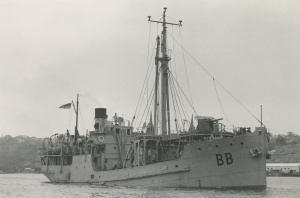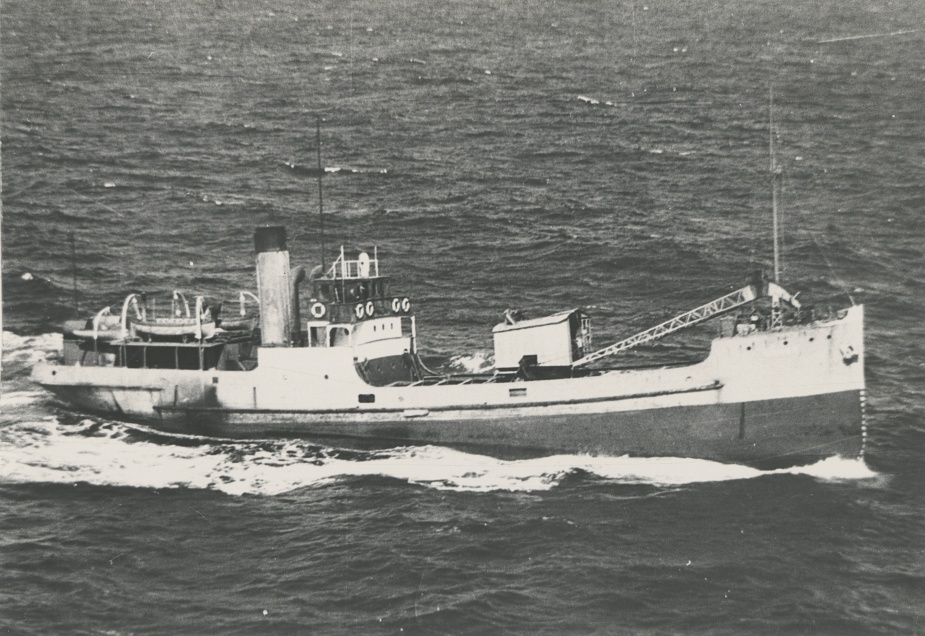HMAS Bombo
| Type |
Coastal Steamer |
|---|---|
| Pennant |
BB |
| Builder |
Henry Robb Ltd, Leith Scotland |
| Commissioned |
28 May 1941 |
| Decommissioned |
25 February 1946 |
| Dimensions & Displacement | |
| Displacement | 540 gross tons |
| Length | 154.3 feet |
| Beam | 23.5 feet |
| Draught | 13.6 feet |
| Performance | |
| Speed | 9 knots |
| Armament | |
| Guns | 1 x 12 pounder gun, 2 x 20 mm Oerlikon anti-aircraft guns |
| Physical Countermeasures | 4 x depth charge |
The coastal steamship Bombo, named for the small suburb in Kiama, was built for the State Metal Quarries of NSW and constructed by Henry Robb Ltd in their shipyard at River Forth, in Leith, Scotland. Bombo was completed in late 1929 and conducted sea trials in 1930, but did not sail for Australia until early February 1933; arriving in Sydney on 23 April 1933.
She was soon put to work carrying bulk cargo of blue metal (basalt aggregate) from Kiama to Sydney for use in the building and road work industries. Averaging five voyages per week this was routine work with the occasional excitement if a load of blue metal shifted in rough weather. On occasions she was overloaded, and heavy seas would break over her forward deck. In March 1938 she was sold to Quarries Pty Ltd but continued on the Kiama to Sydney route under the command of Captain Arthur Bell.
Bombo was requisitioned by the Royal Australian Navy on 22 February 1941, for service as a local defence vessel and commissioned on 28 May 1941 under the command of Lieutenant Arthur Codling, RANR (S). The letters BB were painted prominently on her bow (to enable better and quicker recognition of the hundreds of civilian vessels taken up from trade during the war) and she was initially based at Newcastle, NSW.
Late in 1941 Bombo was converted to an auxiliary minesweeper and relocated to Storm Bay, Hobart and spent much of her minesweeping duties in Tasmanian waters. One of her crew described these duties “It was not boring - it was bloody boring”. Regardless, the auxiliary minesweepers helped keep the ports and sea lanes open in the face of enemy mining and submarine threats throughout the war.
In mid-September 1943 Lieutenant Commander George Roulston, RANR (S) took command of Bombo and prepared the ship for decommissioning and conversion to a stores carrier. Bombo was decommissioned on 10 November 1943 and undertook a refit and removal of her minesweeping equipment. Her weapons outfit was also modified and twin derricks fitted to her main mast for stores loading/unloading tasks. She was recommissioned on 27 January 1944, under the command of Lieutenant Edward Taylor, RANR(S). In early 1944, Bombo was reassigned to stores carrying duties based at Darwin, conducting the essential but unsung task of resupplying Australian units located in northern Australia for the remainder of the war.
In early September 1945 Bombo, now under the command of Lieutenant Archibald Brown, RANR (S), was part of an Allied force (comprising HMA Ships Moresby, Benalla, Echuca, Gladstone, Horsham, Katoomba, Parkes, Warrnambool, Kangaroo and HDMLs 1322, 1324 and 1329), the Dutch minesweeper Abraham Crijnssen, and transport Van den Bosch that steamed from Darwin to Koepang, in western Timor, to enforce the surrender of Japanese forces on 11 September 1945.
Bombo was decommissioned on 25 February 1946 and returned to her owners on 25 July 1947. After a refit, she returned to her pre-war job of carrying cargoes of blue metal under the command of Captain Bell in September 1947. On the morning of 22 February 1949 Bombo departed Sydney on a routine voyage to Kiama to load blue metal. After loading 260 tonnes in her forward hold and another 380 tonnes in her after hold she sailed from Kiama early in the afternoon and was off Port Kembla when she encountered bad weather. A ‘southerly buster’ brought strong winds, driving rain and a south-easterly swell. Captain Bell decided to push on and at 4pm Bombo was abeam of Stanwell Park when a huge wave struck the ship and she rolled to port. Her cargo of blue metal shifted and she took on a list to port; Bell decided to take his vessel south to Port Kembla to shelter for the night.
By 9:30pm Bombo was in sight of the entrance to Port Kembla and made contact, by Aldis lamp, with the harbour duty signalman stating the ship would enter harbour to shelter from the storm. All seemed well, but soon after the ships list to port worsened and at about 10:15pm she rolled over and sank bow first. Of her crew of 14, there were only two survivors (Fireman Michael Fitzsimmons who managed to swim ashore at Woonona Beach, and raised the alarm that Bombo had sunk, and Able Seaman Thorvald Thomsen who was rescued near Bulli Beach). Miraculously the ships dog ‘Brownie’ also made it ashore and was found covered in oil at Bulli Beach. The other twelve men, including Captain Bell, sadly lost their lives. Despite an extensive air and sea search only two bodies were recovered.
The wreck of Bombo was found by scuba divers in 1978 and when it became public knowledge, in 1983, the wreck was pillaged. What remains of the Bombo lies upside down, in 32 metres of water, to the north east of the entrance to Port Kembla. A memorial to her crew was subsequently erected at Black Beach, Kiama, NSW.




